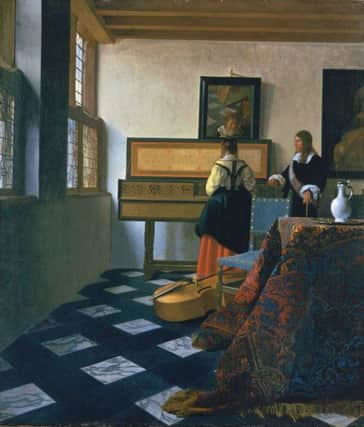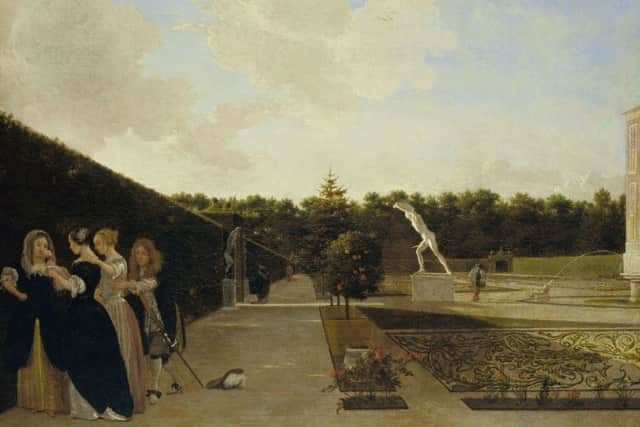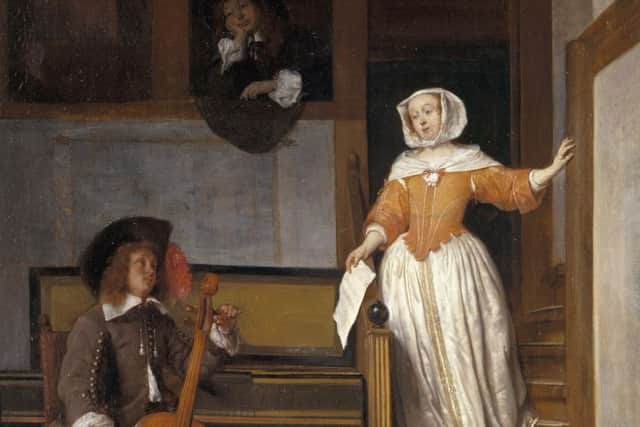Art review: Masters of the Everyday: Dutch Artists in the Age of Vermeer


Masters of the Everyday: Dutch Artists in the Age of Vermeer | Rating: ***** | Queen’s Gallery, Palace of Holyroodhouse, Edinburgh
Masters of the Everyday: Dutch artists in the Age of Vermeer: it’s a good enough title for the latest show at Holyrood to be drawn from the Queen’s apparently inexhaustible collection. The Dutch painters of the 17th century certainly were supreme masters of painting the world around them – and the Queen has a great collection of their work – but too often it has seemed that is all they were: just a charming country branch line while on the mainline the great express of modern art charged past them. The mention of Vermeer in the title does, however, also hint at a level of artistic achievement above the ordinary. Thus it also hints at the momentous imaginative effort it took to turn art away from religion and the elegance of courts and princes to explore instead the nature of experience common to all humanity. That’s the change of direction from which modern ultimately derived.
Advertisement
Hide AdAdvertisement
Hide AdThe Queen’s great Vermeer, Lady at the Virginals with a Gentleman, is here to persuade us, too, that the high points of Dutch painting really are high points. It is a truly wonderful picture. A lady stands at her keyboard, her back to us. A smartly dressed gentleman looks on, an admirer or perhaps simply her teacher. There is a stretch of tiled floor, but a double bass, a chair, and, very close to us, a table covered in a thick oriental rug partly block our view. Above the woman we glimpse her face in a mirror, but if we look closely we can also see part of the artist’s easel there. So before we are tempted to speculate about a romantic narrative along the lines of ‘if music be the food of love etc’, the painter brings us up short. There is no narrative. There is only the light from the windows and in the light there is only the act of seeing, a point mutely demonstrated by the exquisite painting of a white jug on the table.


Nor was Vermeer alone. There are two paintings by Pieter de Hooch here. Both are lovely, but the larger of them, Card Players in a Sunlit Room, is up there with Vermeer as a pure celebration of the act of seeing, or indeed of the beauty of the simple light of day. Four figures are playing cards, three men and a woman. They are against the light from an open door and a high window. Outside a servant crosses a courtyard bringing fresh wine. The lone woman at the table is playing her hand and, if card playing is a metaphor for the game of love, there is marginally more narrative here than in the Vermeer, but only just.
Rembrandt is not in the show, although he is present in the work of several of his pupils, but perhaps he should be here himself too. He was one of the principal agents of the momentous change of direction for painting from the more than human to the simply human and all the complexities that entailed. Among them was the very human conundrum of the business of seeing: how we do construct certainty from something as mutable as perception? Vermeer and de Hooch followed Rembrandt in asking this question and the following century David Hume followed them. Thereafter it runs through the history of modern art to Cézanne and beyond.
Among Rembrandt’s pupils, Gerrit Dou was a key figure celebrated for his minute command of appearances. When the Dutch Republic wanted to give Charles II a present, they chose among other things a painting by Dou. Sent back to Holland by William III and so lost to the Royal collection, this lovely picture has been borrowed back. A young mother is sitting at a window in a lofty room, her baby in a cradle in front of her. There is a mass of incidental detail, but while such compendious observation is what made Dou famous, if you look at the painting of the woman herself, working on her sewing, it has a gentleness and humanity and a quality of observed light that point to the lessons he learnt in Rembrandt’s studio. There is the same quality in the painting of a girl chopping onions, one of two other pictures by Dou here. Nicholas Maes was also a pupil of Rembrandt. In his Listening Housewife, the servants canoodling in the shadows on whom she is eavesdropping, come straight out of a painting by his master.
Gerard ter Borch comes close to Vermeer in his quiet contemplation of people in interiors, although there is a sinister frisson in his beautiful portrayal of the face of a naive girl being plied with wine by a hopeful seducer. Jan Steen, who has more paintings here than anyone else sometimes has this quality too. In A Woman at her Toilet he is close to Ter Borch in his sympathetic portrayal of an ambiguous situation. A woman is sitting on her bed. The catalogue says she is getting undressed, a seductress in fact, but her disheveled appearance, the burnt-out candles, even the marks of the garters on her legs as she pulls on a stocking, suggest she is wearily getting dressed after some amorous encounter. A lute and skull in the foreground suggest a conventional moral, but the simple humanity of the picture undermines any such simplicities. Indeed Steen was generally forgiving both of others and of himself, for he paints himself in a state of great jollity in two of pictures here. In the largest of his Village Revel, he also pays direct homage to Pieter Brueghel who brought the perspective of art down to earth and located it in the ordinary experience. The picture reworks Brueghel’s terrifying Dulle Griet, the personification of war and destruction, as a scene of anarchic merrymaking.


Altogether there is much to enjoy here. Jan Steen is not alone in his ribald sense of fun. Isaac van Ostade’s A Village Fair, with a Church Behind has recently been restored to reveal a man squatting with his trousers down primly painted out by the Victorians. Finally too, a number of these paintings also have a place in the story of Scottish art. Many were bought by George IV and Wilkie clearly saw them. Jan Steen’s Merrymaking in a Tavern, bought in 1814, is, for instance, part of the inspiration of his Penny Wedding, star of the last show here.
• Until 24 July